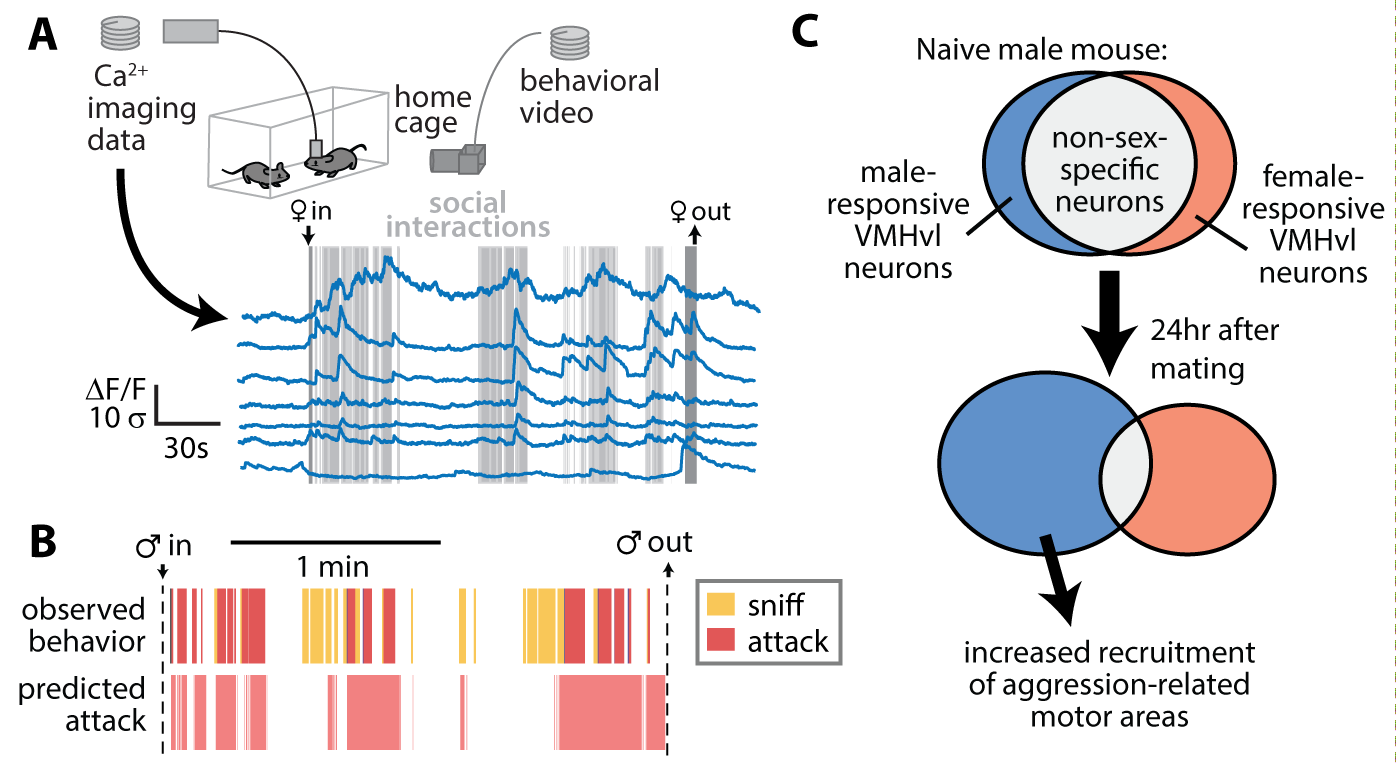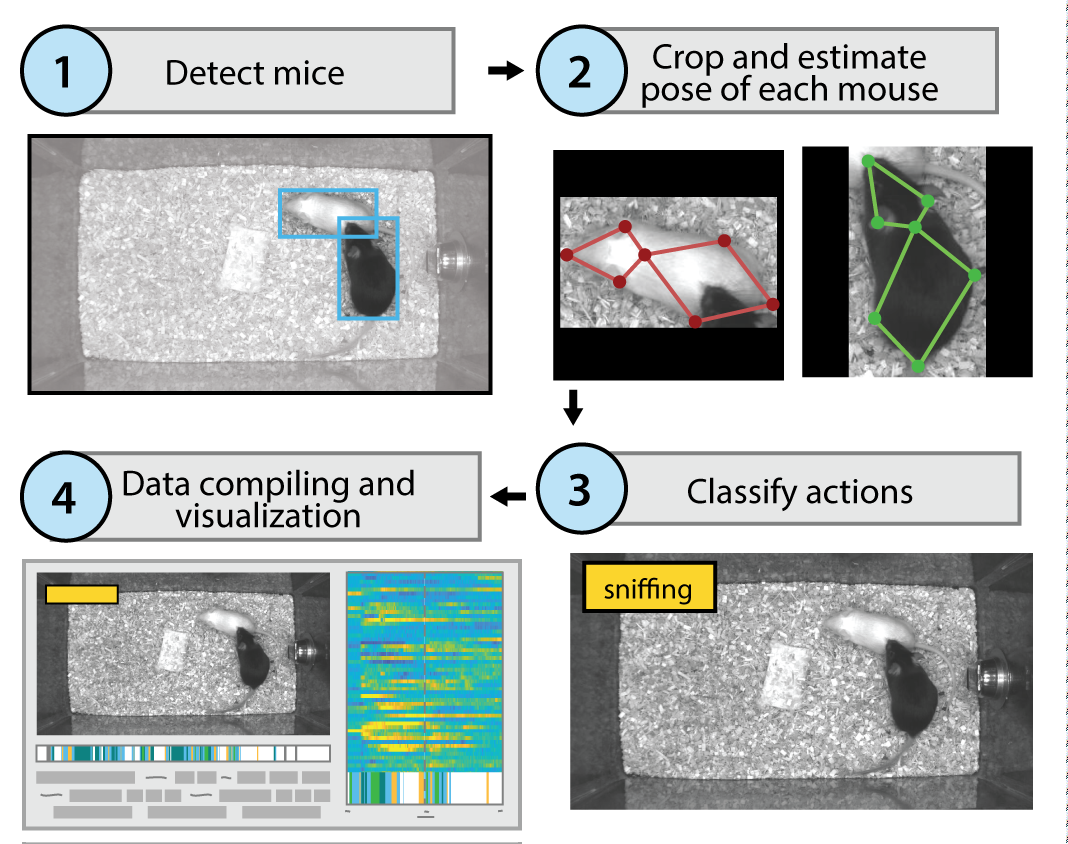
Uncovering internal representations in the hypothalamus
An interview with Dr Ann Kennedy, Northwestern University, conducted by April Cashin-Garbutt
What really makes brains interesting is their flexibility. As we grow and develop, we can change the way we respond to things around us by incorporating our memories and experiences. Unlike simple input/output devices, the flexibility of our brains means we can produce behaviour that is robust and adaptive. Dr Ann Kennedy, Principal Investigator at Northwestern University, recently gave a SWC Virtual Seminar on her postdoctoral work on a part of the brain thought to be involved in the flexibility of naturalistic survival behaviours: the interconnected nuclei of the extended amygdala and hypothalamus. In the following Q&A, she shares her research on hypothalamic representations of internal state and behaviour.
Why is it important for animals to be able to form an internal representation of their environment?
To survive and flourish, animals need to be able to respond to the same sensory cues in different ways depending on their motivational state and experiences. For example, the decision whether to go out and forage for food when an animal has detected a predator recently might depend on whether they’re hungry or satiated. If they’re are hungry, they might be more willing to take a risk and go out to look for food.
Having a representation of both the cues in the environment and also internal motivational state lets the animal change the way they respond based on what they need, their past experiences and where they are developmentally. This internal representation allows a level of flexibility that can’t be achieved with basic input/output mapping of sensory inputs to behavioural responses.
What was previously known about the brain areas involved in forming these representations of internal state and selecting actions?
It has been really difficult for neuroscientists to study the hypothalamus because it is a very deep part of the brain and is also really small. For a long time, our entire understanding of the hypothalamus came from lesions in human subjects or from electrical stimulations that weren’t very precise.
The advent of genetically-targeted tools, like optogenetics and genetically-targeted calcium imaging, really changed what neuroscientists were able to achieve. We can now activate and inhibit specific cell types in the hypothalamus and see what they do. This has only been possible in the last 5-10 years.
What we knew previously about the activity in these regions in naturalistic behaviours was very minimal. We had c-Fos, which lets us identify cells that are active within a half hour window, but the ability to say which specific cells are active during fighting, or mating, or sniffing, has only been possible very recently.
How did you work with experimentalists to uncover how animals’ motivational states and behaviours are represented?
I joined David Anderson’s lab at Caltech as a postdoc as I was interested in recordings from freely behaving animals. We knew from optogenetic studies that the ventromedial hypothalamus nucleus (VMHvl) was involved in the control of aggression and complex behaviour. I joined the lab to help analyse their data and bring in new methods to apply to the datasets.
The first project I worked on in the lab was a VMHvl imaging project with Ryan Remedios. We went in looking to find “attack cells” and “mating cells”, because we knew if we stimulated these cells optogenetically we’d get attack or mating behaviour. But we really struggled to find anything attack-specific in the activity of these cells. What we ended up finding was a total surprise.
Ryan imaged the same animals for multiple days, to get more repeated instances of aggression and mounting. We noticed from day one to day two of imaging that representation of intruder sex looked different across the two days. And the project that initially aimed at analysing behaviour went off into a different direction of how intruder sex representations were changing and trying to figure out why that was the case.
Before I joined the lab, there was another behavioural experiment that had been done by Moriel Zelikowsky, where she took male mice and introduced a male intruder. She then observed the latency for them to initiate attack and also the fraction of them that initiated attack. She did this in naive males and also in males that had interacted with a female either two minutes, an hour, two hours or a day earlier. The mice that had just mated with a female two minutes or an hour ago, or hadn’t mated, showed very little aggression. Mice that had seen a female two hours or a day ago, started fighting with the intruding male straight away.
Moriel’s behavioural experiments showed that there was this priming effect where previous mating experience led to the males being more aggressive the first time they encountered another male. When she mentioned this to me, it was at the point where it was completely separate to Ryan’s experiments. Then when we saw the effect on the VMHvl, we made this connection to Ryan’s data and were able to follow-up on this behavioural result by looking at the comparable-affected neural imaging dataset.

A) We use a head-mounted microendoscope to image neural activity in a mouse during free social interactions; shown below are traces from example neurons in one animal. B) We were able to train a linear decoder to predict bouts of aggression from the activity of VMHvl neurons. C) Our most surprising finding, however, was a dramatic, mating-dependent change in how VMHvl neurons represented the sex of the other mouse.
Were you surprised to find such striking differences across neural populations?
We weren’t expecting the differences in representations between VMH and medial preoptic area (MPO). We didn’t really know what to expect as very few people had recorded in these regions previously. We found that the representations in VMH looked very different from MPO and we are still trying to work out why that is and what that tells us about the hypothalamus as a whole, which has over a dozen of these different nuclei.

MARS computational pipeline for analysing animal behaviour
What is the next piece of the puzzle your research is going to focus on?
I run a computational lab and I’m interested in understanding the control of behaviour in more detail. In the research during my postdoc, the behaviours were defined with manual annotations, where people watched the mice interacting and scored them where they were attacking or sniffing or mating. This is a very coarse way of describing very complex and rich behaviour.
While I was at Caltech during my postdoc I collaborated with a postdoc in Pietro Perona’s lab and we developed a system called MARS – the mouse action recognition system for pose estimation and behavioural classification in mice. MARS can detect automatically sniffing and mounting and aggression.
In my own lab, we’d like to expand the range of behaviours that we can detect automatically and also do more unsupervised data-driven analysis of social behaviour. We’d like to describe the kinds of actions animals are performing in more detail and to look at exactly how behaviour expression changes as you change the state of the animal, such as if it is naïve versus mated, or group-housed versus single-housed. We’d like to know which behaviours are affected by changing state and how are those behaviours co-modulated across states. We want to get at the question of what is the dimensionality of social behaviour in terms of how complex it is. Is each behaviour independently controlled or are they all controlled in a low dimensional common way, or is it somewhere in between? I think figuring this out will help to inform our modelling of neural populations and constrain our theoretical models of behaviour-generation.

About Dr Ann Kennedy
Ann Kennedy is a theoretical neuroscientist investigating neural computation and the structure of behaviour. Her newly founded lab at Northwestern develops machine learning tools for automated quantification and analysis of animal behaviour, and applies these tools in collaboration with experimental labs to better characterize the neural correlates of behaviour in multiple brain regions. She was previously a postdoctoral researcher in the David Anderson research group at Caltech, where she characterized the dynamics of hypothalamic circuits that governs social and fear behaviours, and she earned her PhD with Larry Abbott at the Center for Theoretical Neuroscience at Columbia University, studying neural representations and learning in cerebellum-like structures.


